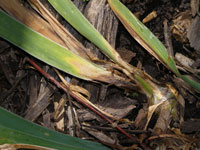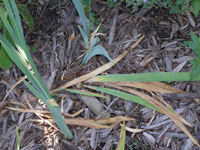Extension > Garden > Diagnose a problem > What's wrong with my plant? > Annuals and Perennials > Iris > Damaged rhizomes
Iris > Damaged rhizomes
1 of 2
Iris Borer
- Damaged rhizomes occur mid summer through fall
- Water-soaked looking streaks in leaves may be noticed in spring
- Yellow or brown streaks especially near the base of the leaf mid to late summer
- Ragged brown leaf tissue at the base of the leaf, may look tattered or have sawdust like frass
- Pinkish or whitish larva with a dark colored head, up to 1 1/2 to 2 inches long inside rhizome
- More information on Iris Borer
2 of 2
Bacterial Soft Rot
Erwinia carotovora
- Leaves turn brown from the tip down with a yellow border between green and brown leaf tissue
- Browning leaves may wilt and fall over
- Rhizome is soft when pressed on and may smell bad
- Inside of the rhizome is soft, mushy and smells bad
- Common in heavy wet soils, and in rhizomes damaged by borer









